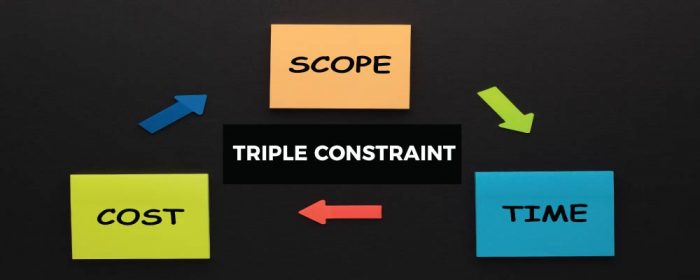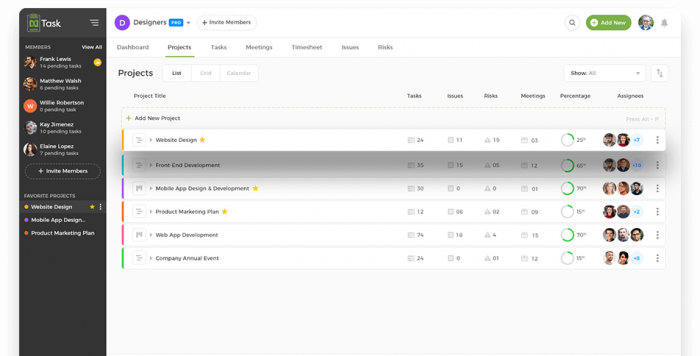If you have been a part of the project management paradigm for a while now, you have probably experienced the triple constraint factor. It’s a combination of different variations that allude to the project timeline and completion eventually.
The Triple constraint or, accurately speaking: project management triple constraints are all the names for the three most essential elements in a project development process.
Therefore, it is safe to say that if you are managing a project right now in the organizational paradigm, you are doing so with the help of the Triple Constraint.
What is Triple Constraint in Project Management?

Also known as ‘the triple constraints of project management.’ the theory highlights every in development and already developed project.
Of course, whenever is said so, it is expected to be done within the confines of the following limits. Hence the expression ‘triple constraints of project management came into existence. Take a look below
These constraints are:
- Time
- Scope
- Cost
This means that the project’s success and failure depend on the deadlines, features, and budget defined by the stakeholders and the manager.
If you are a manager, then you have to juggle all three of these constraints and find the best combination for your project development process.
All of these constraints are inter-connected, and if you want to change something about one of them, the other two will also be impacted.
The Triple constraints have been a part of the project management paradigm for over 50 years, but in recent years we have learned that there are more than just the three constraints.
In this article, we will talk about all of these constraints in detail, but first, we are going to talk about why the Triple constraint is so important for project development processes.
What is the Importance of the Triple Constraint?
The most important benefit of keeping the Triple constraint in mind during the project development process is that the team will be able to adapt to all of the changing conditions that the projects face every day and still complete the development process in time.
Being able to adapt to the changes means that the team can face any obstacles that come in their way, and their performance will not decline, which can potentially jeopardize the project and all of the elements connected to the project.
Now let’s talk about the Triple Constraint in detail.
Triple Constraint Explained
It might seem a bit easy, but when you unearth the details about each constraint, it turns out that you need to know a lot of information. Let’s start.
1. Time

One of the most important elements that managers have is to keep track of time. Time is the constraint that is very important for every single element related to the project development process.
Why? Well, each task and process that is being performed as a part of the project development process has its schedule.
This schedule is the time allocated by the manager or the stakeholders according to the requirements of the project and if this schedule is not met, then the project is in a lot of trouble.
The project planning phase allocates the schedule or the time for each task and process.
This time is based on the market requirements regarding the project and how fast the software or the project has to launch to meet the customer’s demands.
To facilitate the time aspect of the project development process, the tasks and the larger processes are broken down into smaller chunks.
These smaller chunks can be easily executed by the development team, which results in the project development process finishing on time without damaging the reputation of the project and the company.
This schedule of the project development process can be easily managed through a process of effective time management. Here are the steps that you can follow to do that.
- Plan schedule management
- Sequence all of the different activities
- Define all of the activities that are going to be performed in the project
- Estimate the usage of all of the resources that are going to be used in the project
- Estimate the time durations related to each activity
- Develop a proper schedule after analyzing all of the above
- After creating the schedule, you need to control/manage the schedule to make sure that your project is on track and will be a definite success
2. Cost

Cost is another important element related to all the different projects that have been developed or are being developed in the organizational paradigm.
The cost or budget of every task and activity related to the project is different. If you are a manager and you’re not careful, you will run out of resources and money before your project is completed.
The budget processes related to the projects include cost estimation of all of the little cogs in the project development machine.
Here are some of the methods you can use to estimate the cost of the project and everything in it.
- Using Historic Data: This is where you estimate the cost of your project by tracking and analyzing the projects similar to yours, which have been developed in the market over the past years.
- Determining the Resource Costs: Managers determine and track the cost of the goods and labor that are going to be used in the project development process on a per-unit basis.
- Using Different Parameters: Managers can estimate the budget of the project by measuring different stats from the old and new data that they get from the market regarding previous and on-going projects.
- Use Bottom-Up Approach: Managers can also use the bottom-up approach to estimate the budget of the project by tracking the lowest to highest budgets spent on previous projects.
Some other note-worthy methods for budget estimation are:
- Vendor Bid
- Reserve
- Quality Analysis
3. Scope

The third constraint on the list is Scope. The scope is probably the most important part of the project development process, as all the other planning and estimation activities are performed after you have defined the scope of the project.
The project’s scope is defining the tasks and activities being performed in the project development process.
The scope document of the project is a manuscript that includes every little detail regarding the project development process from start to finish.
This document includes the trajectory in which the project will travel and is a map that the team can follow to get back on track if they are derailed from their path.
This document also includes information about the risks and scope creep that the project can potentially encounter in the future.
This is why you need to use project management software like nTask, which will help you track any scope creep and issue that can become a problem in the future and get rid of them before anything happens.
Another important reason to create a scope document or define the project scope is that it calms down the stakeholders.
What does that mean?
It means that the stakeholders related to the project are always concerned about making new additions of tasks and activities in the project development process. Still, if you have a scope defined at the start of the process, anyone of the triple constraints of project management won’t intrude so much in the development process later.
As we have seen in recent years, the Iron Triangle is not a triangle anymore. We have yet more constraints that can be used to keep the project on track to become a success. They are:
4. Quality
This restraint is an important part of the project because if the project is not developed according to the quality agreed in the project scope, the reputation of the company will be seriously damaged.
Unlike the cost and time constraints, the quality constraints apply to the overall output of the project development process. The quality of each task and process is necessary, too, but managers mostly focus on the quality of the end product.
5. Risk
Risk is also an important factor in the project development process. Risks and scope creeps are ‘silent’ project-killers that strike when the development team and the managers are not expecting any threat from them.
This is why, as a manager, you must make sure that you scope out all of the risks and scope creeps before the project goes into the development phase. This helps protect the project from all internal and external threats that can prove fatal in the future.
6. Benefit
Lastly, the benefit of the project elements is also a great motivator to keep the project development process on track.
Check this out:
Project Management Software Guide
Using nTask to Control the Triple Constraint

The Triple Constraint is an important part of the project development process, and if you are a manager, you need to control them to make your project a definite success.
For that, you need to have the most effective project management software in the market, and that is nTask.
The software has some of the most crucial project management features critical to making your project a definite success. These features include task management, time-tracking, and risk management, among many others.
But it’s also the little features responsible for keeping the project on track and decreasing any delay.
These features include:
- Drag and drop simplicity
- Customizable views
- Planned timeline vs. actual timeline
- workload management
- Easy team collaboration
- Team availability
- Dedicated mobile app
Conclusion
So, there you have it. This was a brief explanation of what the Triple constraint of Project management is and how they are crucial for the success of every project being developed in the organizational paradigm.
If you have any problems with sections that we have added to the article or want to add something to the article yourself, feel free to contact us at info@ntaskmanager.com.

